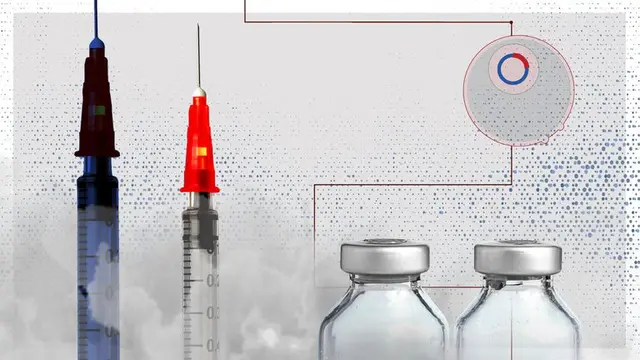The Pfizer/BioNTech COVID-19 vaccine approved for use in the UK is manufactured in Belgium and needs to be stored at -70C (-94F) to avoid spoiling before it is administered.
The government's Joint Committee on Vaccination and Immunisation (JCVI) has confirmed
its priority list
for the first phase of the UK's mass vaccine rollout, which will begin early next week.
These vaccines will need to be transported from Pfizer's manufacturing plant in Belgium to some of the most distant parts of the British Isles, including the Isle of Arran. Here's how that will work:
Live updates on coronavirus from UK and around world
Step 1: Manufacturing
The vaccines destined for the UK are manufactured in Belgium.
They're produced in vials which contain about five doses each, diluted with standard pharmaceutical-grade saline solution.
The vials are placed in trays of around 100, and these trays are stacked in bespoke freezer boxers which are colloquially known as "shippers".
Because the vaccines are based on messenger RNA (mRNA) molecules enveloped in a lipid nanoparticle - something that is very easily destroyed - they need to be stored at a very cold temperature to prevent them from degrading.
Due to the sensitivity of the vaccine, the boxes are all temperature controlled and contain trackers which send minute-by-minute information on the temperature of the box.
This is similar to the way food is prevented from going bad by being kept in the freezer, it prevents the chemical reactions which would cause the molecule to effectively decompose.
The freezer boxes are specially designed to do this for the vaccines, and can hold between 1,000 and 5,000 doses each, with dry ice being used in insulated wall panels to keep the interiors of the boxes cold.
Step 2: Moving the boxes to storage
The pre-packed boxes can then be shipped by refrigerated lorry or plane to a centralised depot in the UK where the batches can be tested for quality control purposes.
Once the vaccine batches are approved they will be moved to storage freezers, where they can be kept for months as long as the temperature is maintained at -70C.
The next steps - once the vaccines are on the road to being administered - are the most time sensitive and challenging logistically.
Step 3: Preparing for distribution
From the centralised depot in the UK, the vaccines will be delivered to 50 hospital hubs around the UK.
Storage at -70C is only necessary in the case of long-term storage, a matter of months, and isn't necessary at vaccination centres
Once stored in boxes and regular fridges, the vaccine can last for over 30 days if the ice is being replaced, and five days otherwise.
These hubs will allocate the vaccine to the local areas that need it according to the government's priority list.
Step 4: Distributing the vaccine
Finally, the vaccine needs to be defrosted before it can be used, which takes several hours, and then additional time is needed to prepare the vaccine for being administered.
The vaccine is administered as a normal intramuscular injection in the arm.
Considering the case of satellite centres, such as care homes, where it will be more feasible to transport the vaccine to the centre rather than bring the patients in, it will be possible to take the vials in a cold transport (2-8C) where they can be administered to residents.
Please use Chrome browser for a more accessible video player

How BioNTech developed their vaccine
This must be done within six hours.
The storage requirements have prompted concerns from Welsh health minister Vaughan Gething, who said the
Pfizer vaccine "cannot" be delivered to care homes
at this stage, despite them being prioritised for receiving the jab.
 简体中文
简体中文

